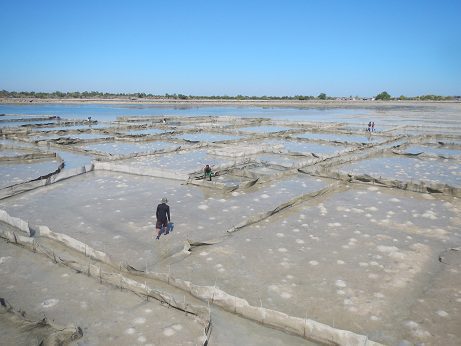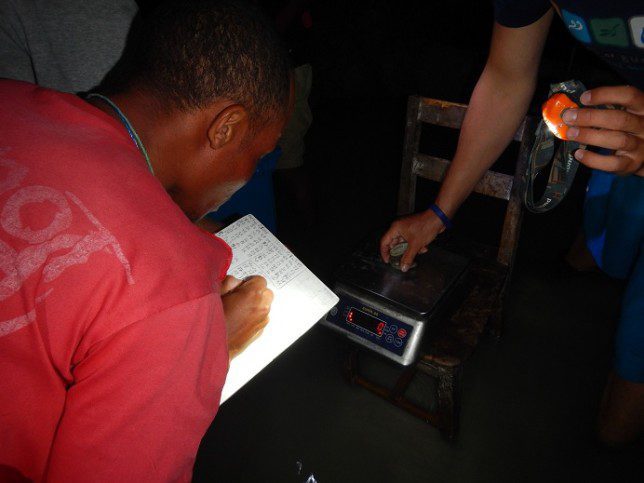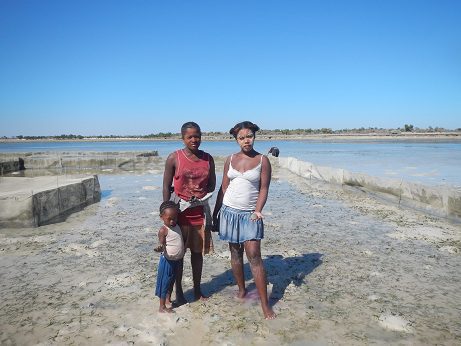By Madison Kane, Expedition Manager, Madagascar
On a Friday afternoon, after some beautiful morning dives, the expedition volunteers eagerly await their ride to Tampolove; a trip I have always said is one of my favourites. Jaws drop and gasps of surprise arise when the local camion approaches Coco Beach. ‘That’s our ride?!’ a volunteer shouts as we stare at the almost military-truck like vehicle with a tarpaulin draped across its back. ‘It’s all part of the experience’ I remind them, as we climb into the back and prepare ourselves for a bumpy journey ahead. However, unlike most camion journeys the locals experience, which can be journeys with 100 people crammed in the back – we were only 22 of us, on a 45 minute jaunt to Anjafy.
As we arrived in Anjafy, which is located south of Andavadoaka, our three trusty conservation captains, Bevick, Mamonjy, and Zeferin, were just arriving with motorized pirogues to take us across the bay to Tampolove. Within a few minutes of travel, the waves had picked up; soaking us all like one of those log flume rides at an amusement park. With quickly changing water conditions and sopping wet clothes, the ‘Bay of Assassins’ was living up to its name. Although conditions were rocky and we all got a little wet, we remained safe and arrived in Tampolove with some time to dry off, have a beer, and relax before dinner.

The sea cucumber pens in Tampolove
Everyone stood patiently waiting to be paired up with another volunteer or member of staff and to meet their homestay family. Dinner on the trip to Tampolove isn’t your ordinary meal back at Coco Beach, the volunteers’ home whilst on an expedition in Andavadoaka. As part of the experience, and a great chance to practise Malagasy, volunteers are paired up and join a local family for dinner. Although every family seems friendly and welcoming, we choose to join families that help the Blue Ventures aquaculture team so that volunteers have an opportunity to meet the farmers they will later be assisting and ask questions. Having already learned the words such as ‘Zanga’, Malagasy for Sea Cucumber, in Josvahs presentation before we left, volunteers were ready to learn more. As we joined the families at their house, we asked questions about their jobs, family, and how to say various words in Malagasy. After a delicious meal of fresh caught octopus, and the usual rice and beans, we thanked our family for their generous hospitality and returned back to base for a quick nap, a game of cards, and a very aggressive round of Bananagrams. Most volunteers were incredibly grateful to have the brief opportunity to see how life differs in the village from Coco Beach. In my opinion, it’s a must do experience when on an expedition.
Around midnight, we met up with the local farmers and the aquaculture team to head out to the sea cucumber pens to help the farmers monitor their stock. It happens at night during a spring tide because it must be a very low-tide and also dark as that’s when the sea cucumbers come out to graze and are easier to find. Due to the light of the full ‘super moon’ this month, we were guided without torches and the usual petrol lanterns to the pens; carrying scales, buckets and weigh tables. As we arrived at the pens, we were split back with the families that cooked us dinner and helped them monitor their pens. We collected 30 sea cucumbers from about 25 pens and weighed each one to find an average weight. The farmers then compare this to the last spring tide monitoring session to see the growth of their cucumbers. By around 2am, we were all chilly and ready for bed.

Helping out with the sea cucumber monitoring
We awoke to the sunrise and the sound of the roosters crowing. Though we were all ready for a bit more sleep, the standard breakfast of boko-boko and coffee was on the table and we knew we had a full day ahead of us. Following breakfast, we met Bevick and a few seaweed technicians to learn about seaweed farming. We helped the team measure out fifty 10m lines, which will later be used in the water to cultivate seaweed. They then lead us out to where the seaweed farm was and showed us how they harvest and cultivate the seaweed. Once harvested, the seaweed is brought to land, dried in the sun, shipped and sold. This technique has become a regular alternate livelihood for many Malagasy’s on Madagascar’s southwest Coast.
Once we had consumed all the knowledge we could about seaweed, we returned to the sea cucumber pens to see what they look like in daylight. Volunteers had the opportunity to climb up the guardian tower and have a birds-eye view of the pens. We once again met our farmers and helped them clean their pens by scrubbing the nets and ousting crabs (who predate on the sea cucumbers). Clean nets increases the nutrient flow through the pens and removing crabs decreases mortality of the cucumbers. By doing this, we are ensuring maximum growth rate and production for the farmers. After a few hours of serious scrubbing, we were more than ready for a cold drink and some lunch. We returned to Richards and enjoyed some fish, beans, and rice. After lunch, we packed our bags and prepared for the journey home. Even as a staff member who has been in Andavadoaka for over 1.5years, I’m always looking to learn more, so quickly decided that before we leave I’d go take a look at the local well that Safidy helped build two years ago. A few volunteers joined me as we walked through the village and towards the mangroves to the well. It was a great opportunity for volunteers to see one of the ways Safidy is making a difference in the area.

Some of the sea cucumber farmers (and families) of Tampolove
We made our way back to Richards, grabbed our bags and met Mamonjy and Bevick to begin our journey back home. The crossing through the bay was far more enjoyable as it was sunny and calm. Once we made it to Anjafy, we jumped in the camion and headed back to Andavadoaka. We made it home just in time for a shower, our usual pre-dinner Vao Vao and much needed sleep. Though quick, this trip to Tampolove is one of my most memorable activities in which volunteers have the opportunity to participate in. It’s a jammed-packed learning experience which shows them a few successful alternative livelihoods programmes for fishing villages along the southwest coast of Madagascar.

